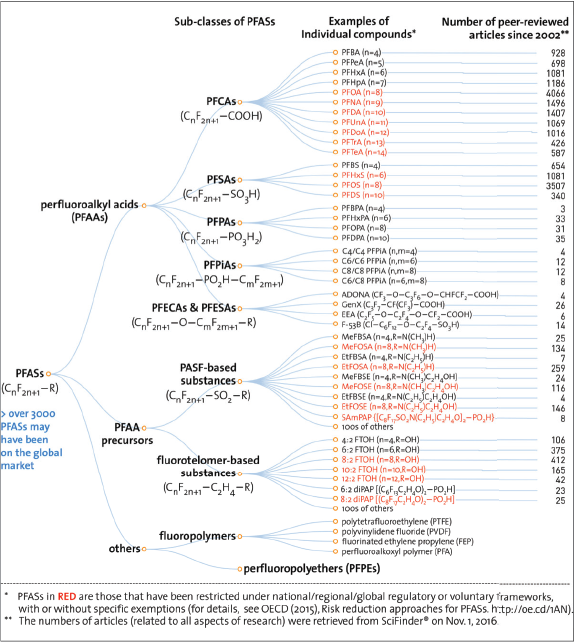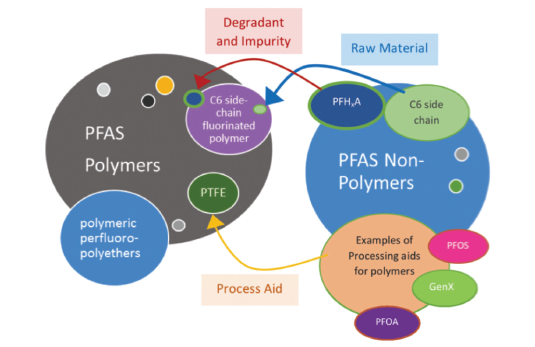Fluoropolymers such as PTFE, PVDF, FEP, and PFA are a group of polymers found within the Per and PolyFluoroAlkyl Substance (PFAS) naming syntax.
By Tim Goedeker, Consultant, and Gobind Khiani, P.Eng., Fellow, Mechanical Engineering – Piping/Pipelines
Chemical Compound Naming
The term PFAS is a broad, non-specific term, that does not inform whether a chemical compound is harmful or not, but indicates only that the chemical compound has a fully fluorinated methyl or methylene carbon group.1 All PFAS chemical compounds, of which there are 4,700+ are similar in a naming convention only.2 The term is based on chemical structure alone.1 Most PFAS chemical compounds are not similar in physical properties, end use, benefits to society, or impacts to nature and the environment. To draw much, if any, conclusion or inference from another chemical compound included in the PFAS umbrella is folly.2
PTFE Characteristics
PTFE (polytetrafluoroethylene) is a polymer consisting of very long perfluorinated alkyl chains. By naming syntax only, it is a PFAS, but like all PFAS, it has different characteristics than other PFAS chemical compounds.3 High molecular weight fluoropolymers, like PTFE, are highly stable (chemically and thermally), too large to be bioavailable, non-toxic, and not mobile in the environment. Per the governing body OECD (Organization for Economic Cooperation and Development) many fluoropolymers, like PTFE, meet their criteria of “Polymers of Low Concern” as their properties present low health and environmental concern.4
PTFE has been tested many times and proven, for example, in medical products or implants and, unlike perfluorooctanoic acid (PFOA) and perfluorooctane-sulfonic acid (PFOS), cannot accumulate in the environment or living organisms.

PTFE End Use Benefits
In their finished form PTFE polymers are corrosion resistant, have low frictional characteristics (allows easy movement of machine parts), thermal stability, and effective sealing capability. In sealing products, PTFE prevents leakage from industrial equipment. Seals that utilize PTFE polymers reduce leaks to nearly zero, making them a cornerstone in the efforts to reduce fugitive emissions. The use of PTFE liners and packing has enabled valve manufacturers to significantly reduce the fugitive leaks, including methane, from process valves which has reduced the generation of greenhouse gases.
It was first used during World War II as a sealing device in equipment used to transport uranium hexafluoride. This supermaterial was critical to the development of nuclear fusion. PTFE is a supreme and irreplaceable material in numerous industries. PTFE is also the best performing material in applications where low emissions of volatile organic compounds are required by law.6
PTFE Production Process
Major US manufacturers of PTFE products for industrial applications do not use certain PFAS with known health risks, specifically PFOA-perfluorooctanic acid or PFOS, in the PTFE manufacturing process and have not done so since 2002.7 PTFE is produced by free-radical polymerization of tetrafluoroethylene.8
Granular PTFE is produced via suspension polymerization, where PTFE is suspended in an aqueous medium primarily via agitation. PTFE is also synthesized via emulsion polymerization, where a surfactant is the primary means of keeping PTFE in an aqueous medium. Surfactants, in the past, included PFOA and PFOS. As mentioned above, the practice of using PFOS and PFOA as processing aids in the US and in the EU in the early 2000s.
PTFE is not PFOA or PFOS.

Concerns with PFOS and PFOA
Certain fluorinated methyl or fluorinated methylene-based chemical compounds, specifically, perfluorooctanic acid (PFOA) and perfluorooctane sulfonic acid (PFOS) chemicals, used in 1) household applications – stain & water-resistant products, non-stick cookware coatings, and 2) commercial applications – fire fighting foam (AFFF) – were found to be possibly harmful. PFOS was phased out of production and use in 2002 and U.S. manufacturers eliminated PFOA emissions and product content at the end of 2015. As a result manufacturing processes and products previously relying on PFOA and PFOS were modified to use replacement chemical compounds.
Exposure to PFOA and PFOS
The four major routes of PFOA PFOS exposure are: 1) firefighting training sites using Aqueous Film Forming Foams (AFFF) for fighting fires, 2) industrial sites, 3) landfills, and 4) wastewater treatment plants/biosolids10, see Figure 1.12 The PFOA and PFOS can get into drinking water when products containing them are used or spilled onto the ground or into lakes and rivers.9 AFFF are synthetic foams containing PFOS or PFOA designed for flammable liquid fires. The PFOS & PFOA serve as surfactants that spread the foam to cool and suppress the fire. Because of their persistence in the environment, as they do not break down quickly and will remain in the environment virtually permanently, and their well-documented health effects, these two specific chemicals are largely being phased out in the U.S.
Firefighting Foams
The foams primarily used for industrial firefighting (AFFF) have been manufactured with PFAS (PFOA and PFOS). How- ever, now there are alternatives that are certified fluorine-free. The Class A/B fire-fighting foam, PHOS-CHEK® 1% fluorine-free foam concentrate, is one available mixture of water and hydrocarbon surfactants. Developed for use on Class B hydrocarbon fuel fires, the organohalogen-free foam is an environmentally responsible next-generation product – does not contain intentionally added PFAS chemicals including PFOA and PFOS.
While PFAS chemicals are environmentally persistent, an important distinction among the PFAS chemicals is they exist in different states — solids, liquids, and gases.
The state greatly impacts mobility through air, water and soil. For example, the liquid state of PFAS-containing firefighting foam (AFFF) contributes greatly to its ability to contaminate soil and water.
Additionally, there are physical size differences between PFAS non-polymer substances such as PFOA and PFOS and PFAS polymers such as PTFE. A non-polymer consists of a single molecule; whereas, a polymer can consist of thousands of repeating molecular units. The relatively small size of non-polymers (PFOS, PFOA) makes them more mobile — easy to spread in air and waterways — and more bio-available — with increased potential to build up in blood and body tissues where they might do harm. High molecular weight fluoropolymers, like PTFE, are highly stable, chemically and thermally, are too large to be bioavailable, are non-toxic and not mobile in the environment.

In Summary
The term PFAS indicates only that a PFAS chemical has a fully fluorinated methyl or methylene carbon group. PFAS are a collection of chemicals used to make many products, ubiquitous to everyday life, including fluoropolymers.
A number of non-polymer chemicals – specifically PFOA and PFOS – have been branded as “forever chemicals” because testing has shown they don’t break down in the environment quickly.
A science-based approach, utilizing standard testing, is necessary to understand each unique PFAS chemical and determine acceptable levels of use. The science-based approach should be used to regulate chemicals such as PFOA and PFOS, and products such as AFFF, deemed harmful.
The intent of this article is to bring awareness to some unique properties of fluoropolymers, specifically PTFE. In addition, this article highlighted concerns with certain non-polymer PFAS chemicals (PFOA and PFOS). This article is not intended to conclude or not conclude that fluoropolymers are of “low concern”.
References:
- Reconciling Terminology of the Universe of Per- and Poly_ uoroalkyl Substances: Recommendations and Practical Guidance; Organisation for Economic Cooperation and Development; OECD Environment, Health and Safety Publications; 9 July 2021 – https://www. oecd.org/chemicalsafety/risk-management/synthesispaper-on-per-and-poly_ uorinated-chemicals.htm
- Reference – “PFAS Regulations Report From the Fluid Sealing Association”, Pumps & Systems, 2/14/2022
- DOI: https://pubs.acs.org/doi/10.1021/acs.est.6b04806, A Never-Ending Story of Per- and Poly_ uoroalkyl Substances (PFASs)?, Environ. Sci. Technol.; February 22, 2017; 51, 2508−2518
- “PFAS Regulations Report From the Fluid Sealing Association”, Pumps & Systems, 2/14/2022
- 11/16/22 – https://www.pumpsandsystems.com/why- legislators-should-narrow-list-dangerous-pfas
- “PFAS Chemicals and PTFE: Should the Valve Industry be Concerned”, Valve Magazine, 1/1/2022]
- https://en.wikipedia.org/wiki/Polytetra_ uoroethylene
- R. Renner, “The long and the short of per_ uorinated replacements,” Environ. Sci. Technol., vol. 40, no. 1, pp. 12–13, Jan. 2006.
- L. S. Haug, S. Huber, G. Becher, and C. Thomsen, “Characterisation of human exposure pathways to per_ uorinated compounds — Comparing exposure estimates with biomarkers of exposure,” Environ. Int., vol. 37, no. 4, pp. 687–693, May 2011
- Ennviron.Sci. Technol.2020, 54, 12820-12828
- R. Dhore, G.S. Murthy, “Per/poly_ uoroalkyl substances production, applications and environmental impacts’, Bioresource Technology, Volume 341, December 2021, https://www.sciencedirect.com/science/article/abs/pii/ S0960852421011494




